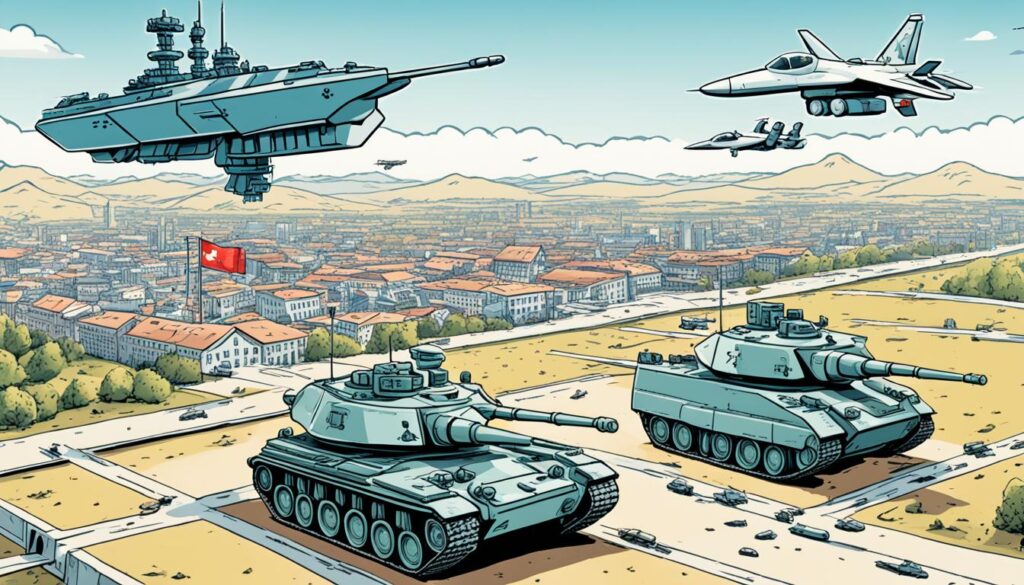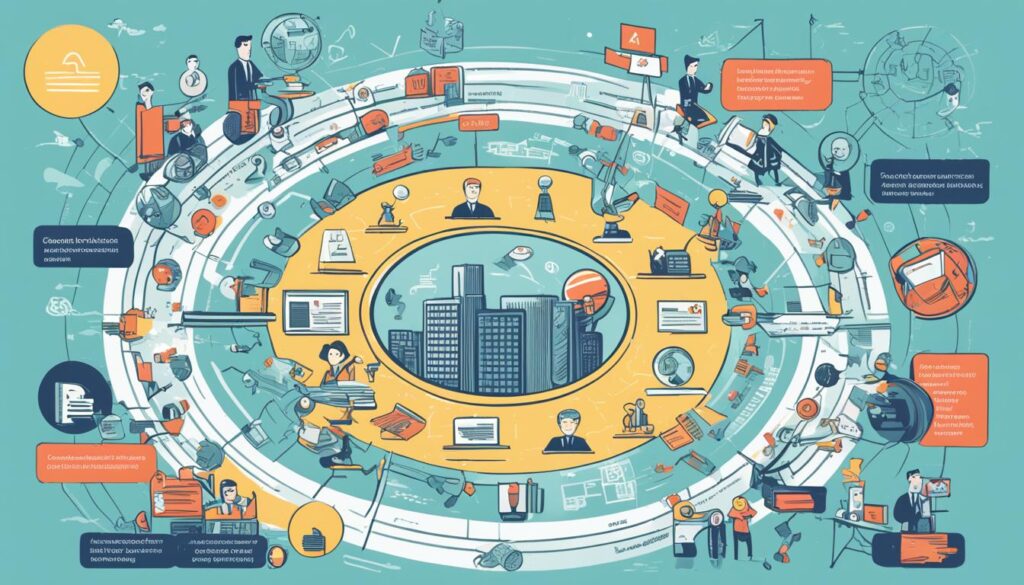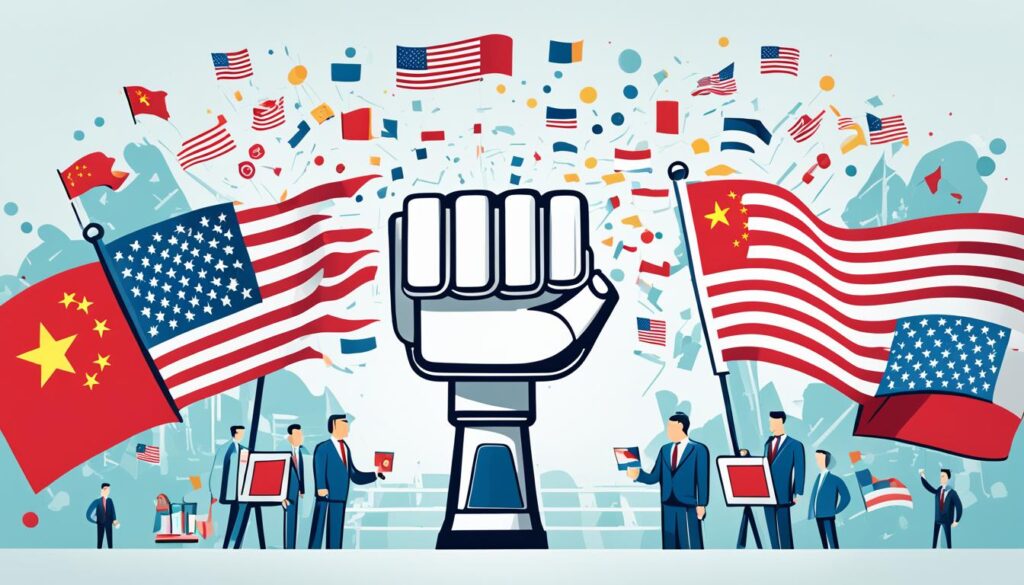In the last ten years, AI has grown from playing simple video games to solving complex scientific problems like protein folding. This shows how big the stakes are in the AI race between global leaders. Exploring AI reveals how this rivalry is changing our future.
The AI race is more than just a competition. It affects our economy, science, and global power. China is now on par with the US in AI research papers, showing its growing strength in this area.
Looking into AI, you’ll see how it’s changing fields like healthcare and national security. You’ll also learn about the risks, like losing jobs and spreading false information. Knowing these points helps understand the US-China AI competition better.
Keep reading to learn about the current state, main players, and strategies in this important tech race. By the end, you’ll know more about what’s at risk and how it might impact your future.
The Current State of AI Competition
The race in AI between the US and China has grown more intense, changing the world of technology. You might be curious about how these two leaders compare in AI. Let’s explore the latest developments and debunk some myths.
Public Perceptions of US-China AI Rivalry
Many believe the US and China are equally matched in AI. A recent survey found 83% of Chinese companies use generative AI, while 65% in the US do. This fact might surprise you, but it’s important to look deeper.
Historical Precedents in Technological Competitions
The US has often underestimated its tech rivals before. Remember the Space Race? Similar worries were there back then. Now, despite what it seems, the US leads in AI innovation and its use in the economy.
Misconceptions About China’s AI Progress
China has filed over 38,000 patents for generative AI from 2014 to 2023, more than the US. But, having more patents doesn’t mean they’re all top-notch. The US is ahead in advanced AI, like large language models. ChatGPT beats out China’s Baidu’s ERNIE bot. The US also leads in AI hardware and open-source software, key for AI growth.
It’s important to understand the real picture of the AI race between the US and China. China is investing a lot, with a $1.4 trillion plan for AI and tech. But, the US keeps its lead through innovation and practical use. The competition is tough, but it’s not as even as it seems.
Understanding the AI Race Dynamics
The race in AI innovation between the U.S. and China is changing the world. It’s not just about making the best tech. It’s about how fast a country can use new AI in its economy.
China has challenges in using new tech, especially in rural areas. But, AI progress means it’s hard to keep a lead. The scaling hypothesis says bigger AI models with more data and power do better, no matter the task.
This means China can still get better, despite its challenges. With its strong AI ecosystem, talent, and corporate support, China is growing fast. The U.S., however, is focusing on ethical AI and using it in the military more effectively.
The battle for AI supremacy is not just about making the best AI. It’s about using it well in the economy and society. Both countries are investing a lot, for economic and security reasons. This competition is changing industries, job markets, and global power balance.
US and China in the AI Race: Key Players and Strategies
The AI race is intense between the US and China. Both are racing to lead in AI research and development. The US is ahead in advanced computing hardware and cutting-edge chips. China is facing issues with keeping and attracting top talent.
US Government Initiatives and Private Sector Contributions
A bipartisan group of senators in the US wants to increase federal AI spending by $32 billion a year. The private sector is booming, with OpenAI’s ChatGPT having over 180 million users. US companies are great at finding and keeping AI talent, thanks to top education and innovation.
China’s AI Ambitions and Investment Strategies
China wants to be a top AI leader by 2030. It has about 260 generative AI startups, with Baidu’s Ernie Bot having 200 million users. China is investing a lot in AI research and development and has a strong plan for industrial change.
Comparative Strengths and Weaknesses
The US is leading in chatbots and advanced computing hardware. China is facing issues with tech development and funding for AI startups. China is investing in autonomous weapons and AI in the military but is struggling with rules and keeping talent. The US has an advantage with a bigger English-speaking internet, helping its AI research and development.
The Role of AI in Military and National Security

The U.S. and China are racing ahead in AI technology for the military. They see AI as a game-changer for war strategies and national safety. This competition is pushing forward fast changes in how military AI works.
AI is making a big difference in how wars are fought. It can look through huge amounts of data much quicker than people, helping make faster decisions on the battlefield. The Pentagon is working on many AI projects, like making unmanned warplanes controlled by AI. Recently, an AI-led F-16 beat human pilots in dogfighting, showing how powerful this tech is.
China’s hacking skills are a big worry for national security. Chinese hackers have gotten into sensitive U.S. government and business systems, taking important data. This shows we need strong AI-powered security to fight back against such threats.
But, using AI in war raises big ethical questions. Current AI systems might not be ready for complex battle situations. We need international rules on how to use AI in war. Working together to set these rules is key to making sure AI is used right and safely in future wars.
Economic Implications of AI Dominance
The race for AI leadership between the US and China is changing the world economy. As AI research grows, so does the economy. This brings big changes to jobs and how much work gets done.
Global Market Impact
AI is having a huge effect on the economy. Accenture says AI could make the global economy grow twice as fast by 2035. This is because AI could make workers 40% more productive. The battle for AI leadership is also a fight for economic power.
Job Market Transformation
The AI revolution is changing the job market in big ways. A CNBC survey found 24% of American workers worry they might lose their jobs to AI in five years. Workers earning less could face up to fourteen times the risk of needing a new job. Even Bill Gates talked about a ‘robot tax’ to help those losing jobs due to AI.
Innovation and Productivity Boost
AI is pushing innovation in many fields. The US National Science Foundation thinks making AI research more open could cost $2.6 billion. This money is to help the US stay ahead. As AI gets better, we’ll see more work getting done and new chances for economic growth.
Ethical Considerations and AI Governance
Artificial intelligence is changing fast, making ethical thoughts and rules key to its future. The push for global AI leadership highlights the need for strong rules and policies.
In the US and China, AI rules differ a lot. China sees AI as a way to keep things stable. The US trusts companies to regulate themselves. This shows how each country values different things culturally and ethically.

China has strict rules on AI, especially for AI that creates new content. They worry about controlling information. They use AI for social credit scores and fine tech companies for privacy issues. The US, on the other hand, is moving slowly on AI laws, leaving it up to companies to decide.
Both countries face challenges like AI bias, privacy, and misuse. The White House gave $140 million to tackle AI ethics. US agencies warn about AI bias to stop unfair treatment.
As AI gets better, we need global standards and rules more than ever. Even though the US and China compete, working together could help make AI safer and fairer for everyone.
Collaborative Efforts and International Standards
The world of AI is changing fast. Countries see the value in working together. They’re setting standards to tackle AI challenges.
Joint Technical Committees and Working Groups
Groups from around the globe are coming together to make AI standards. These teams have experts from many countries. They work on ai policy and regulation to make sure AI is developed responsibly.
Balancing Competition with Cooperation
Countries are racing to lead in AI, but they also know the need for teamwork. The Global Partnership on AI, started by G-7 nations in 2018, shows this balance. It focuses on making AI responsible and respecting each country’s interests.
The Need for Global AI Governance Frameworks
AI’s impact is growing, so we need global rules. The EU’s AI rules are a big step towards this. Working together is key to solving big issues like climate change and pandemics with AI. By joining forces, we can make sure AI helps everyone while keeping our values like openness and democracy safe.
Future Trajectories of AI Development
The battle between the US and China in AI is changing the future of tech. AI will greatly affect the world’s economies. McKinsey & Company predicts AI could add $13 trillion to the global economy by 2030. This shows how important the AI race is.
China and the US have different ways of using AI. China has 176 million security cameras and plans for 626 million by 2020. This gives China an edge in training AI. The US, on the other hand, has more earth observation satellites and top universities, with 41 in the top 100.
The US is ahead in supercomputing power, with five of the top ten supercomputers. But China has 227 supercomputers in the top 500, showing its growth. Both countries are investing in quantum computing, which will be key in the future.
As AI grows, we must balance innovation with ethics. The US faces issues with tech companies not wanting to work on military AI. China’s less strict data laws might speed up AI progress. Knowing these trends will help us as AI changes industries, jobs, and global power.
